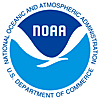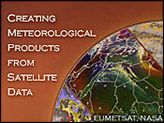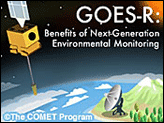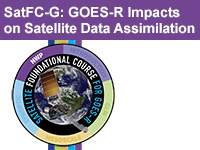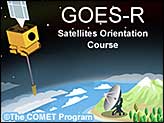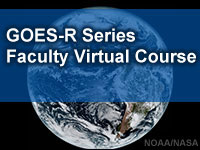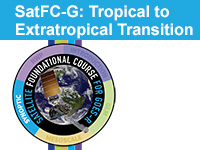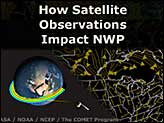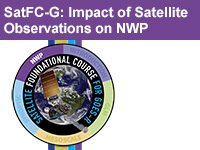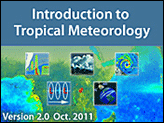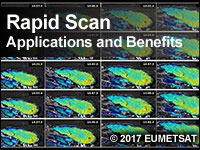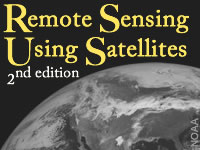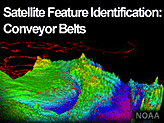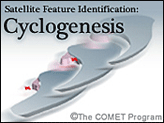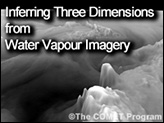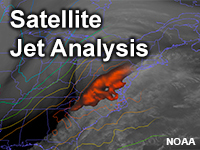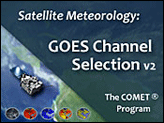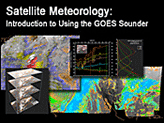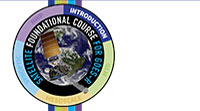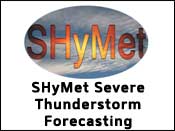Training: GENERAL SATELLITE METEOROLOGY
Click on the thumbnail images or links below to launch/redirect to each training course.
Cooperative Program for Operational Meteorology, Education, and Training (Comet)
 The Cooperative Program for Operational Meteorology, Education, and Training supports, enhances, and stimulates the communication and application of scientific knowledge of the atmospheric and related sciences for the operational and educational communities. COMET’s web-based self-paced training materials serve earth science education and training needs by providing interactive experiences for learners at a distance. Experts at both the Cooperative Institute for Meteorological Satellite Studies (CIMSS) and the Cooperative Institute for Research in the Atmosphere (CIRA) contributed to many of these lessons.
The Cooperative Program for Operational Meteorology, Education, and Training supports, enhances, and stimulates the communication and application of scientific knowledge of the atmospheric and related sciences for the operational and educational communities. COMET’s web-based self-paced training materials serve earth science education and training needs by providing interactive experiences for learners at a distance. Experts at both the Cooperative Institute for Meteorological Satellite Studies (CIMSS) and the Cooperative Institute for Research in the Atmosphere (CIRA) contributed to many of these lessons.
Creating Meteorological Products from Satellite Data
Creating Meteorological Products from Satellite Data: This module presents an overview of how satellite data are turned into the satellite products used by operational forecasters and the research and educational communities, etc. This module is also available in French and Spanish.
GOES-R: Benefits of Next-Generation Environmental Monitoring
GOES-R: Benefits of Next-Generation Environmental Monitoring: An overview of the GOES-R mission, instruments, system and services, satellite synergy, the role of GOES-R in the Global Observing System as well as environmental monitoring section that addresses the benefits of GOES-R and the ability to monitor 13 unique hazards and phenomena. This module is also available in Spanish.
GOES-R Impacts on Satellite Data Assimilation
GOES-R Impacts on Satellite Data Assimilation: This five-minute lesson presents a brief overview of how GOES-R Series observations are expected to support and potentially enhance numerical weather prediction for various analysis and forecast applications.
GOES-R Satellites Orientation Course
GOES-R Satellites Orientation Course: This course consists of three self-paced lessons, “GOES-R: Benefits of Next-Generation Environmental Monitoring,” ”GOES-R ABI: Next Generation Satellite Imaging,” and “GOES-R GLM: Introduction to the Geostationary Lightning Mapper,” that introduces forecasters, students, researchers and other interested learners to the capabilities, products and applications anticipated with the next-generation GOES-R satellites. This module is also available in Spanish.
GOES-R Series Faculty Virtual Course
GOES-R Series Faculty Virtual Course: This webinar series provides an introduction to the new capabilities offered by the latest-generation GOES-R Series weather satellites to provide university faculty and others with a solid basis for using GOES-R/16 data in coursework and student research projects.
GOES-R Tropical to Extratropical Transition
GOES-R Tropical to Extratropical Transition: This lesson uses water vapor satellite imagery from Himawari-8 to describe the typical extratropical transition of a tropical cyclone. The Himawari-8 imager previews comparable capabilities coming online with the GOES-R Series Advanced Baseline Imager.
How Satellite Observations Impact NWP
How Satellite Observations Impact NWP: Satellite observations have a huge impact on numerical weather prediction (NWP) model analyses and forecasts. This lesson discusses the use of satellite observations in NWP and how model limitations prevent more of the data from being assimilated. Included are expected advances in NWP from GOES-R.
Impact of Satellite Observations on NWP
Impact of Satellite Observations on NWP: This lesson covers how satellite data inform numerical weather prediction models. From a basic overview of how satellite data is assimilated to how a new instrument's data might get into a model.
Introduction to Tropical Meteorology, 2nd Edition, Chapter 2: Remote Sensing
Introduction to Tropical Meteorology, 2nd Edition, Chapter 2: Remote Sensing: This chapter focuses on remote sensing—the primary method of observing weather and climate across the global tropics. We will explore how remote sensing is used and examine the types of information that it provides over formerly data-void regions. This module is also available in Spanish.
Rapid Scan Applications and Benefits
Rapid Scan Applications and Benefits:This lesson introduces the capabilities and benefits of rapid scan imaging from geostationary meteorological satellites with a special focus on the current Meteosat Second Generation satellites. The lesson begins with an overview of current rapid scan imaging strategies and the products made from those observations. It then addresses nowcasting applications that benefit from these products with a focus on convection and its evolution. Other application areas that benefit from rapid scan observation are mentioned including the monitoring of fog and low stratus, wildfires, tropical cyclones, and atmospheric motion vector data. The final section describes the new and next-generation rapid scan datasets from international satellite operators around the world and improvements for advancing weather analysis and prediction.
Remote Sensing Using Satellites, 2nd Edition
Remote Sensing Using Satellites, 2nd Edition: The second edition of the "Remote Sensing Using Satellites" module updates imagery of recent hurricanes as well as other phenomena from more recent satellites. Learn about remote sensing in general and then more specifically about how it is done from satellites. The lesson focuses on the visible and infrared channels, those commonly seen on television broadcasts.
Satellite Feature Identification: Conveyor Belts
Satellite Feature Identification: Conveyor Belts: This lesson highlights important atmospheric processes that can be advantageous for making weather forecasts. In this lesson, learn to identify conveyor belts using water vapor imagery.This module is also available in French.
Satellite Feature Identification: Cyclogenesis
Satellite Feature Identification: Cyclogenesis: This module uses water vapor satellite imagery to present a satellite perspective of basic features associated with the formation and development of extratropical cyclones.
Satellite Feature Identification: Inferring Three Dimensions from Water Vapour Imagery
Satellite Feature Identification: Inferring Three Dimensions from Water Vapour Imagery: Water vapor imagery can help us break out of flatland and move to more dimensions. This imagery holds so much under-utilized potential. We can actually see three-dimensional structures evolving in near-real-time. Come see the atmosphere in 3D using water vapor imagery! This module is also available in French.
Satellite Jet Analysis
Satellite Jet Analysis: This lesson explains how to identify jets and jetstreaks using satellite water vapour imagery. It begins by finding the jetstream and synoptic longwave pattern using a set of five key identifiers. The lesson then moves on to locating jetstreaks within the jetstream using a set of four similar, refined indicators. The lesson concludes with an example where learners can synthesize all of the identification methods through analyzing all jetstreams and jetstreaks present in a single case.
Satellite Meteorology: GOES Channel Selection Version 2
Satellite Meteorology: GOES Channel Selection Version 2: This module includes significant updates to the module "Satellite Meteorology: GOES Channel Selection." It still reviews the five GOES imager channels and their use, incorporating updated technical information, conceptual visualizations and numerous imagery examples. This module is also available in Spanish.
Satellite Meteorology: Introduction to Using the GOES Sounder
Satellite Meteorology: Introduction to Using the GOES Sounder: This module, adapted for the Web from the CD-ROM released in 1998, reviews GOES sounder characteristics, data products, and applications concurrent with the GOES I(8)-P satellites. This module is also available in Spanish.
Virtual Institute for Satellite Integration Training (VISIT)
 Virtual Institute for Satellite Integration Training (VISIT) is a joint effort involving NOAA Cooperative Institutes, the National Environmental Satellite Data and Information Service (NESDIS), and the National Weather Service (NWS). The primary mission of VISIT is to accelerate the transfer of research results based on atmospheric remote sensing data into NWS operations using distance education techniques. Training sessions include topics on satellite meteorology, severe weather, climate, numerical weather prediction, and more.
Many of these modules were developed in collaboration with the Cooperative Institute for Meteorological Satellite Studies (CIMSS) and the Cooperative Institute for Research in the Atmosphere (CIRA). VISIT also provides satellite chats to demonstrate satellite products that can be applied to operational forecasting and identify new training topics based on specific participant needs. See the VISIT Training Calendar for upcoming teletraining sessions.
Virtual Institute for Satellite Integration Training (VISIT) is a joint effort involving NOAA Cooperative Institutes, the National Environmental Satellite Data and Information Service (NESDIS), and the National Weather Service (NWS). The primary mission of VISIT is to accelerate the transfer of research results based on atmospheric remote sensing data into NWS operations using distance education techniques. Training sessions include topics on satellite meteorology, severe weather, climate, numerical weather prediction, and more.
Many of these modules were developed in collaboration with the Cooperative Institute for Meteorological Satellite Studies (CIMSS) and the Cooperative Institute for Research in the Atmosphere (CIRA). VISIT also provides satellite chats to demonstrate satellite products that can be applied to operational forecasting and identify new training topics based on specific participant needs. See the VISIT Training Calendar for upcoming teletraining sessions.
VISIT Training Sessions:
VISIT offers a wide selection of satellite remote sensing training materials. See the VISIT Training Sessions webpage for a complete listing.
FDTD Satellite Application Webinars:
The National Weather Service Forecast Decision Training Division (FDTD) Satellite Application Webinars are peer-to-peer learning; staff from Weather Forecast Offices (WFOs), National Centers, Center Weather Service Units (CWSUs), and River Forecast Centers (RFCs) lead the presentations. The webinars to share how to apply GOES imagery with other datasets for a specific operational application.
SHyMet: Satellite Foundational Course for GOES-R/16
SHyMet: Satellite Foundational Course for GOES-R/16: This National Weather Service (NWS) Satellite Foundation Course for GOES-R/16 contains 37 short training modules to bring forecasters, the scientific community, and others up-to-date on the capabilities of the GOES-R/GOES-16 satellite.
SHyMet Severe Thunderstorm Forecasting
SHyMet Severe Thunderstorm Forecasting: The Severe Thunderstorm Forecasting track of the SHyMet course covers how to integrate satellite imagery interpretation with other datasets in analyzing severe thunderstorm events.



